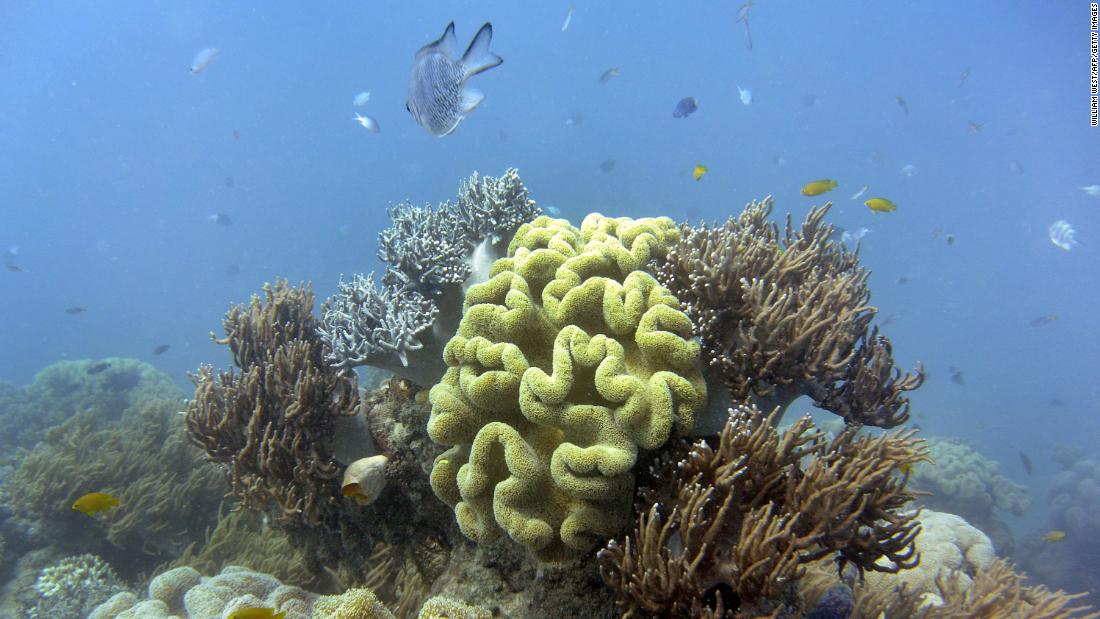(CNN) — The Australian government and a United Nations body are facing off this week over whether the Great Barrier Reef is “in danger” of losing its “outstanding universal value.”
Australia has desperately tried to avoid that scenario through a flurry of last minute lobbying, including taking ambassadors on a snorkeling trip to the reef.
Its efforts may have paid off. Twelve out of the 21 countries on the Committee appeared to be against applying the “in danger” rating to the Barrier Reef, according to a proposed amendment posted to the UNESCO site on Tuesday.

Fish swimming through the coral on Australia’s Great Barrier Reef on September 22, 2014.
William West/AFP/Getty Images
“There is still time to save the Great Barrier Reef, but Australia and the world must act now,” reads the letter, signed by “Aquaman” actor Jason Momoa and ocean explorer Philippe Cousteau, among others.
Battle for the reef
But the Australian government has strongly objected to UNESCO’s conclusion. Environment Minister Sussan Ley flew to Europe in July as part of a last-ditch attempt to convince the other 20 members of the World Heritage to vote against the measure. Australia is currently part of the 21-country rotating committee.
In an amendment proposed on Tuesday, 12 countries on the committee, including Russia, Saudi Arabia and Spain, appeared to back a suggestion to not impose an “in danger” rating on the Barrier Reef, but no final decision has been made.
In a statement, a spokesman for Ley said while in France she had met delegates from a number of countries.
“Australia’s position remains that the Great Barrier Reef is the best managed reef in the world, supported by more than $3 billion of Commonwealth and State Government funding. Australia is concerned that the draft listing process did not include appropriate levels of consultation or a reactive mission,” the spokesman said.
But Dr. Fanny Douvere, head of the World Heritage Center’s Marine Programme, defended the “in danger” rating as “unbiased” and “scientifically-based.”
She said no matter how the World Heritage Council voted on Friday, UNESCO’s draft decision that the reef was “in danger” would still represent their considered opinion.
“The evidence is not something that we’re investigating, the evidence is something that is very clearly described,” she said.
“It would simply not have been credible not to alert the international community about the situation.”
An alert to the world
UNESCO’s World Heritage List contains hundreds of sites deemed to be of great value to future generations, from natural wonders such as Yellowstone National Park in the US to cultural wonders like the Great Wall of China.
Every year the World Heritage Committee meets to decide whether to add new properties to the list and to evaluate whether any of the current ones are at risk.
Douvere from the Marine Programme said an “in danger” listing sends a signal to the international community that the sovereign nation responsible for that property is struggling to maintain it and needs assistance. UNESCO will then work with the country to determine what needs to happen to ensure the Heritage Listed-site is rescued.
“It’s a serious decision, it’s not something we take overnight … It is really an alert to the international community that a place that is on the World Heritage List, something we want to preserve for future generations … is losing its outstanding universal value,” she said.
“This draft recommendation has been made without examining the reef first hand, and without the latest information,” Ley said in a statement at the time.
In the past, “in danger” ratings have been lifted after the relevant authorities addressed issues raised by UNESCO.
Scientists support ‘in danger’ rating
“The last couple of years have revealed that recovery is underway across much of the GBR, a promising sign illustrating that the GBR still has the capacity and necessary ecological functions to recover from disturbances,” said the report.
But prominent Australian scientists said the new coral growth is fragile and backed the move by UNESCO to put the Great Barrier Reef on the “in danger” list.
Scott Heron, an associate professor in physics at Queensland’s James Cook University, said it was “very clear” to him the reef was in serious trouble.
“The threats that the Great Barrier Reef is facing are serious, they have been ongoing and there has not been an achievement of the goals that were set,” he said. Heron said although some coral had returned after bleaching events in recent years, a lot of the regrowth was a fast growing variety which was particularly susceptible to heat stress and death.
“This one year’s worth of information is a variability that looked at alone would mask the longer term trend of decline,” he said.
In a statement to CNN, Minister Ley’s spokesman said the Australian government opposed the “in danger” rating, “not only because of our concern in relation to the Reef, but because we believe the process risks damaging the integrity of the World Heritage System.”
But Lesley Hughes, spokeswoman for the Climate Council and a distinguished professor of Biology at Macquarie University, said she believed the Australian government was also concerned about being embarrassed over its poor record on climate change.
“So while the government is pointing to the amount of money they spent on local adaptation (on the Barrier Reef), they are still not serious and have never been serious about dealing with climate change,” Hughes said.
“An ‘in danger’ listing of the reef will just draw more attention internationally to the government’s failure in that respect.”
CNN’s Helen Regan contributed to this article.
